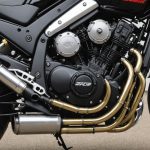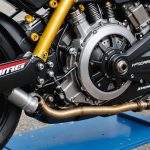Understanding Rearsets and Their Importance
In the world of sport biking, rearsets are critical components that significantly influence a rider’s experience. They are the footpeg and control assemblies that define a sport bike’s ergonomics, playing a crucial role in positioning the rider for optimal comfort and control. By adjusting the footpeg and control positions, rearsets enhance sport bike comfort, particularly during aggressive riding and track days.
Installing rearsets offers numerous benefits. They allow cyclists to tailor their bike’s ergonomics to their specific body types, leading to a more customisable and comfortable riding experience. Riders can adjust the foot position, which aids in reducing strain during long rides and thus enhances comfort. This is crucial for maintaining endurance over time.
In parallel : Ultimate guide to seamless quick-release fuel tank installation for effortless refueling in uk sport bike racing
Moreover, rearsets offer significant advantages when it comes to installation benefits. Many rearsets are designed for easy adjustment and can be installed without extensive modification to the bike. This means riders can experience immediate comfort gains and improved ergonomics without complicated changes.
Ultimately, rearsets are an essential investment for sport bike enthusiasts looking to improve their riding comfort while accommodating their specific body types and preferred riding positions. Customisable and ergonomic, they represent a practical upgrade for enhancing both performance and comfort on the road.
Also read : Essential tips for optimizing sport bike suspension: enhancing passenger comfort on british roads
Necessary Tools and Materials for Installation
Installing rearsets on your motorcycle requires meticulous preparation and understanding of the necessary installation tools and components.
First, ensure you have the essential tools: a set of hex keys, wrenches, screwdrivers, a torque wrench, and pliers to handle various fittings with precision. Keep lubricants and thread lockers nearby for securing bolts effectively.
Next, consider the types of rearset components you’ll need. These typically include footpegs, brackets, heel guards, and shift levers. The choice of material, whether aluminium or carbon fibre, can affect performance and aesthetics. It’s vital to select components that suit your ride style and ergonomic needs.
A proper workspace setup is key to a safe installation. Ensure your area is well-lit with ample room to manoeuvre. A motorcycle stand will provide stability, preventing any unintended movement during installation. Organize your tools within easy reach, and maintain a clean environment to avoid misplacing small parts.
By equipping yourself with the correct tools, understanding your rearset components, and arranging a proficient workspace, you’ll ensure a seamless and efficient installation process. This preparation will ultimately enhance your riding experience, offering improved comfort and bike control.
Step-by-Step Rearset Installation Process
Installing rearsets on your sport bike can enhance both performance and comfort. Here’s a detailed DIY guide to help you through the installation process.
Before starting, ensure you’ve gathered all necessary tools and equipment. Begin by removing the existing footpegs. This typically involves unscrewing bolts and disconnecting any attached linkage. Consult your bike’s manual for specific sport bike mechanics related to your model.
Once you’re ready to proceed with installing the new rearsets, follow these essential steps:
-
Mount the Rearset Bracket: Align the bracket with the designated mounting points on your bike. Fit the bracket snugly and secure it with the provided bolts.
-
Attach the Footpeg: Place the new footpeg into position and screw it into the bracket. Ensure it’s tightly secured to prevent any movement.
-
Connect the Linkage: Attach the shift and brake linkages, adjusting them to match your desired foot position. This step is crucial for maintaining control and comfort.
-
Align and Adjust: Check the alignment of the rearsets. Proper alignment is quintessential for optimal performance and ergonomics.
To verify the success of your installation, perform a thorough check on each connection. Adjust any components if necessary, ensuring everything is tightened to the appropriate torque specifications.
Adjusting Rearsets for Optimal Comfort
Fine-tuning your motorcycle’s rearset adjustment can dramatically enhance your riding experience. It’s essential to ensure that rearset positioning is aligned with your personal riding style. Different riding styles demand varying levels of comfort tuning. For instance, sports riders might prefer a more aggressive stance, whereas touring enthusiasts favour a relaxed setup.
Ergonomic fitting hinges on understanding how adjustments impact your body posture. Proper adjustment can alleviate stress on the knees and lower back, leading to a more comfortable ride. It can also enhance agility, allowing you to manoeuvre with greater precision. Incorrect adjustments could result in discomfort or even increase the risk of injury.
Avoid common mistakes such as adjusting rearsets without considering your overall body posture. Misalignment can lead to fatigue or even soreness on longer rides. Instead, approach adjustments methodically:
- Experiment incrementally: Make slight changes and test each modification.
- Prioritise balance: Ensure equal weight distribution to maintain stability.
- Seek expert advice: Consult a professional if uncertain about the optimal settings.
By approaching rearset adjustment with caution and understanding, you can ensure a more ergonomic and comfortable fit tailored to your unique needs.
Addressing Challenges of British Road Conditions
Navigating British road conditions presents unique challenges for motorcyclists. These include frequent encounters with potholes and uneven surfaces, which can significantly affect both riding comfort and bike handling. Riders often face discomfort and instability, which could potentially compromise safety. Therefore, understanding and addressing these challenges is crucial for a smoother and safer journey.
Adjusting the rearsets on your motorcycle can play a pivotal role in enhancing comfort and control. By repositioning the footpegs and control levers to better suit your riding posture, you can achieve greater stability and responsiveness. This not only minimises impact from road irregularities but also reduces fatigue over longer distances.
To improve safety during rides, consider these strategies:
- Customise rearset positions: Adjust according to personal comfort and height to find a position that enhances balance.
- Monitor handling response: Pay attention to how changes in rearset adjustments affect the motorcycle’s response to bumpy surfaces.
- Regular maintenance: Ensure rearsets and associated components are in good condition to maintain control during rides.
By adopting these methods, riders can transform challenging road conditions into manageable experiences, thereby increasing overall riding enjoyment and safety.
Safety Precautions During Installation and Adjustment
Installing and adjusting motorcycle rearsets involves a level of technical complexity that must be handled with care to ensure safety. Employing appropriate safety measures can significantly reduce the risks involved. To begin with, wearing safety gear, such as gloves and goggles, is crucial to protect against injuries during the installation process. Using proper tools and maintaining a clean workspace further ensures a safer environment.
One of the common risks associated with improper installation or adjustment is compromised riding stability, which could lead to accidents. An incorrectly set rearset can also result in poor riding posture, causing discomfort or even pain during rides. Therefore, understanding the manufacturer’s instructions thoroughly and ensuring each component is tightly secured is paramount.
To ensure everything is in order, follow best practices for testing the installation. Start by performing a stationary check, ensuring the rearset is secure, and there is no unwanted movement. Conduct a slow-speed test ride to verify functionality, paying attention to any unusual vibrations or noises. Ensuring all adjustments are precise secures a smoother and safer riding experience, averting potential mishaps that arise from negligence during the installation phase.
Visual Aids and Additional Resources
Understanding how to properly install and operate a new system can be challenging. This is where diagrams and instructional videos become invaluable. These visual aids break down complex processes into manageable steps, allowing users to follow along at their own pace. An effective diagram can depict the layout of components, offering a clear blueprint for assembly or troubleshooting. Similarly, instructional videos provide a dynamic guide, often addressing common pitfalls or frequently asked questions, ensuring viewers have a solid understanding.
For those eager to deepen their knowledge, seeking further reading on specific topics is highly beneficial. Many manufacturers and technical forums provide downloadable manuals that delve into technical details. These comprehensive guides are excellent for those who enjoy self-directed learning and wish to understand the “why” behind each step.
Additionally, joining community forums or social media groups dedicated to technical support can provide ongoing assistance. These platforms allow users to share insights, ask questions, and exchange advice. Being part of such communities not only furnishes additional support but also connects individuals with similar interests, fostering a collaborative environment.











